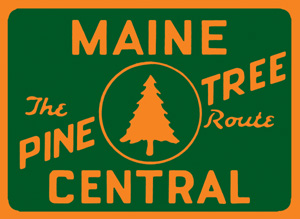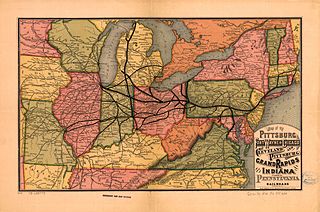Related Research Articles

The New York Central Railroad was a railroad primarily operating in the Great Lakes and Mid-Atlantic regions of the United States. The railroad primarily connected greater New York and Boston in the east with Chicago and St. Louis in the Midwest, along with the intermediate cities of Albany, Buffalo, Cleveland, Cincinnati, Detroit, Rochester and Syracuse. New York Central was headquartered in New York City's New York Central Building, adjacent to its largest station, Grand Central Terminal.

The Delaware, Lackawanna and Western Railroad, also known as the DL&W or Lackawanna Railroad, was a U.S. Class 1 railroad that connected Buffalo, New York, and Hoboken, New Jersey, and by ferry with New York City, a distance of 395 miles (636 km). The railroad was incorporated in Pennsylvania in 1853, and created primarily to provide a means of transport of anthracite coal from the Coal Region in Northeast Pennsylvania to large coal markets in New York City. The railroad gradually expanded both east and west, and eventually linked Buffalo with New York City.

The Maine Central Railroad was a U. S. class 1 railroad in central and southern Maine. It was chartered in 1856 and began operations in 1862. By 1884, Maine Central was the longest railroad in New England. Maine Central had expanded to 1,358 miles (2,185 km) when the United States Railroad Administration assumed control in 1917. The main line extended from South Portland, Maine, east to the Canada–United States border with New Brunswick, and a Mountain Division extended west from Portland to St. Johnsbury, Vermont, and north into Quebec. The main line was double track from South Portland to Royal Junction, where it split into a "lower road" through Brunswick and Augusta and a "back road" through Lewiston, which converged at Waterville into single track to Bangor and points east. Branch lines served the industrial center of Rumford, a resort hotel on Moosehead Lake and coastal communities from Bath to Eastport.

The Michigan Central Railroad was originally chartered in 1832 to establish rail service between Detroit, Michigan, and St. Joseph, Michigan. The railroad later operated in the states of Michigan, Indiana, and Illinois in the United States and the province of Ontario in Canada. After about 1867 the railroad was controlled by the New York Central Railroad, which later became part of Penn Central and then Conrail. After the 1998 Conrail breakup, Norfolk Southern Railway now owns much of the former Michigan Central trackage.
The Michigan Air Line Railroad was a railroad across southern Michigan, connecting the Canada Southern Railway to Chicago, Illinois. Only part of the line was built before the company that first built it folded, and it was split between the Michigan Central Railroad and the Grand Trunk Railway, which completed the line.

The Mid-Michigan Railroad is a railroad owned by Genesee & Wyoming. It operates 39.8 miles of track in Michigan.
The Detroit, Lansing and Northern Railroad (DL&N) is a defunct railroad which was formed on December 27, 1876 as a reorganization of the foreclosed Detroit, Lansing and Lake Michigan Rail Road. The segment of its main line from Detroit to Lansing became an important component of the Pere Marquette Railroad, organized in 1900, and is still in use by CSX.
The Chicago and Michigan Lake Shore Railroad (C&MLS) is a defunct railroad which operated in Michigan between 1869 and 1878, and as the Chicago and West Michigan Railroad until 1881.
The White River Railroad was a wholly owned subsidiary of the Chicago and West Michigan Railroad incorporated on November 13, 1879, for the purpose of constructing a rail link north from the C&WM's line at White Cloud to the Flint and Pere Marquette Railroad's main line (Ludington–Monroe) at Baldwin, and to exploit the ample timber resources of the White River area. On April 1, 1880, the White River opened a 13-mile (21 km) line from White Cloud north to Merrill Township, in Newaygo County. In 1881 the line was extended a further 4 miles (6.4 km) to what would become Bitely in 1889. In either late 1883 or no later than February 7, 1884, the White River completed the line all the way to Baldwin, for a total length of 29.86 miles (48.06 km).
The Patterson Railroad is a defunct railroad that existed in Michigan during the early 1870s. The company incorporated on September 21, 1870 and filed articles on October 3 to construct a line between Patterson Mills and Kiddville. The Patterson completed a 1.67-mile (2.69 km) in July 1872, at which point the property became part of the Detroit, Lansing and Lake Michigan Railroad, whose line it met at Kiddville. The DL&M would later become part of the Pere Marquette Railroad, which also built a line south from Belding.
The Ionia and Lansing Rail Road is a defunct railroad which operated in the state of Michigan in the 1860s and 1870s. The company incorporated on November 13, 1865; the investors hailed primarily from Lansing, Ionia and Portland. The original charter called for a 34-mile (55 km) line from Ionia to Lansing; on January 13, 1869 this was amended with a much grander vision: a 125-mile (201 km) line from Lansing to the mouth of the Pentwater River at Pentwater, on the shores of Lake Michigan.
The Detroit and Howell Railroad (D&H) is a defunct railroad organized in 1864 to build a line connecting Howell and Detroit in southeast Michigan.

The Mansfield, Coldwater and Lake Michigan Railroad (MCW&LM) is a defunct railroad which operated in southern Michigan and Ohio during the 1870s. By the time it went into foreclosure in the late 1870s it owned two non-contiguous track segments, each of which was leased by a different company.
WALLY was a commuter rail service proposed in 2008 which would have linked the Michigan cities of Ann Arbor and Howell. It never got past the planning stages.

The Hocking Valley Railway was a railroad in the U.S. state of Ohio, with a main line from Toledo to Athens and Pomeroy via Columbus. It also had several branches to the coal mines of the Hocking Valley near Athens. The company became part of the Chesapeake and Ohio Railway system in 1910, and the line between Toledo and Columbus continues to see trains as CSX Transportation's Columbus Subdivision. Portions of the main line south of Columbus are now operated by the Indiana and Ohio Railway and Hocking Valley Scenic Railway.
The Plymouth Subdivision is a freight railroad line in the U.S. state of Michigan. It is owned by CSX. It connects the Plymouth Diamond at milepost CH 24.5 to Grand Rapids at CH 148.1, passing through the Lansing metropolitan area en route. Other towns served include South Lyon, Brighton, Howell, Fowlerville, Williamston, Grand Ledge, Lake Odessa, Clarksville, and Alto. Operationally, it is part of the CSX Chicago Division, dispatched from Jacksonville, Florida.

Lansing Manufacturers Railroad was a beltline switching railroad organized in 1904 to connect Cornelius Vanderbilt's Michigan Central mainline on the north edge of Lansing, Michigan, to automotive factories on the west and south side of the city and to Sir Henry Tyler's Grand Trunk Railroad along the north bank of the Grand River. The company's 5.1-mile (8.2 km), C-shaped right of way lay entirely within the city limits. Important customers included GM's Reatta Craft Centre, Lansing Metal Center, and both plants of Lansing Car Assembly.
The Northern Central Michigan Railroad (NCMR) was a railroad line in the U.S. state of Michigan. The line ran from Lansing to Jonesville, then returned north from Jonesville to Albion and Eaton Rapids before closing the loop in Lansing. The NCMR had a short life as an independent company, becoming part of the Lake Shore and Michigan Southern Railway in 1871 and then consolidating with the New York Central Railroad in 1914.
The Kalamazoo and White Pigeon Railroad (K&WP) was a shortline railroad in the U.S. state of Michigan. The line ran from Lansing to Jonesville, then returned north from Jonesville to Albion and Eaton Rapids before closing the loop in Lansing. The NCMR had a short life as an independent company, becoming part of the Lake Shore and Michigan Southern Railway in 1871 and then consolidating with the New York Central Railroad in 1914.
References
- Henry Varnum Poor (1889). Manual of the railroads of the United States, Volume 22, page 422.